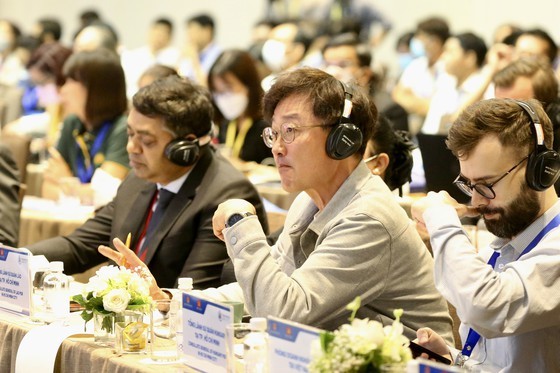 Many foreign enterprises participate in the Fourth Vietnam Economic Forum. (Photo: SGGP)
Many foreign enterprises participate in the Fourth Vietnam Economic Forum. (Photo: SGGP)
Fast-growing but unstable
Speaking at the opening of the conference, Deputy Minister of Finance Nguyen Duc Chi said that policies and solutions for the development of the capital market had paid attention to, with the goal of building a transparent and efficient capital market, making it become a medium and long-term investment and capital mobilization channel for enterprises. In the 2016-2021 period, the capital market has had a rapid development step in the right direction. The size of the capital market grew at an average rate of 28.5 percent per year in the 2016-2021 period. By the end of the first quarter of 2022, the capital market reached 134.5 percent of the GDP of 2021, 3.5 times higher than the size of 2015. In which, the stock market capitalization is equivalent to 93.8 percent of the GDP, and the bond market size is 40.7 percent of the GDP. However, from the beginning of April 2022, the stock market made many corrections, in which real estate stocks dropped sharply. The issuance of corporate bonds by real estate enterprises has grown rapidly in scale but also posed many risks and inadequacies.
Mr. Pham Hong Son, Vice Chairman of the State Securities Commission (SSC), assessed that the stock market has continuously grown strongly in terms of capitalization, liquidity, and the number of investors, especially domestic individual investors. The size of the stock market has gradually balanced with the bank capital market. However, there are also many limitations and inadequacies. Specifically, many cases of stock price manipulation occur in the stock market; the derivatives market becomes increasingly sophisticated and complex; the corporate bond market is risky when many individual investors do not understand the market; some auditing organizations and appraisal organizations have limited capacity.
For the real estate sector, according to a report by the Ministry of Construction, although the economy was affected by the pandemic, the prices of real estate, houses, and land plots have continuously climbed since the beginning of 2021. By the end of 2021, prices of apartment buildings rose by 5-7 percent on average; prices of individual houses in projects surged by 15-20 percent; land prices escalated by 20-30 percent compared to the end of 2020.
Promoting transparency instead of tightening
Experts assessed that developing the capital and real estate markets is important content contributing to building an independent and self-reliant economy. For these two markets to grow sustainably, the most crucial issue is to focus on solutions to promote transparency instead of tightening.
Mr. Nguyen Quang Thuan, CEO of FiinGroup, said that the trend of credit control for real estate enterprises is correct but not a sustainable solution to make the market healthier. The data by FiinGroup surveyed 54 real estate businesses listed on the stock exchange shows that credit and corporate bonds only account for 31 percent of corporate debt structure. Meanwhile, most of the capital sources are from cooperation contracts with other businesses or prepayments from customers.
On the other hand, while bank credit for real estate in 2021 was only VND700 trillion, capital from homebuyers was nearly double at over VND1.3 quadrillion. Over the past time, the pandemic and the delay in legal approval have affected the project implementation progress, making it difficult for enterprises to access capital from prepayments of homebuyers. As a result, enterprises recorded low short-term profit growth, putting more pressure on bond maturity, with 63 percent of bond value by the end of April 2022 to be due in 2024. “Government needs to have policies to support enterprises to mobilize capital more effectively, based on ensuring benefits harmoniously for individual investors," said Mr. Thuan.
Regarding solutions to develop a stable stock market, Mr. Pham Hong Son said that in the coming time, SSC would focus on perfecting the legal framework in the direction of increasing transparency and developing stably and sustainably. In the immediate future, it would direct and coordinate with the stock exchanges and the Vietnam Securities Depository to build and put into operation a trading floor for the private placement of corporate bonds to step up the supervision of the use of corporate bonds and information disclosure according to regulations. “The SSC will also study and report to the Ministry of Finance and recommend the Government to submit to the National Assembly for an overall review of the provisions of the Law on Securities, including public offering, private placement, the concept of professional securities investors, and regulations on handling violations in the market," said Mr. Son.
Speaking at the opening of the conference, Deputy Minister of Finance Nguyen Duc Chi said that policies and solutions for the development of the capital market had paid attention to, with the goal of building a transparent and efficient capital market, making it become a medium and long-term investment and capital mobilization channel for enterprises. In the 2016-2021 period, the capital market has had a rapid development step in the right direction. The size of the capital market grew at an average rate of 28.5 percent per year in the 2016-2021 period. By the end of the first quarter of 2022, the capital market reached 134.5 percent of the GDP of 2021, 3.5 times higher than the size of 2015. In which, the stock market capitalization is equivalent to 93.8 percent of the GDP, and the bond market size is 40.7 percent of the GDP. However, from the beginning of April 2022, the stock market made many corrections, in which real estate stocks dropped sharply. The issuance of corporate bonds by real estate enterprises has grown rapidly in scale but also posed many risks and inadequacies.
Mr. Pham Hong Son, Vice Chairman of the State Securities Commission (SSC), assessed that the stock market has continuously grown strongly in terms of capitalization, liquidity, and the number of investors, especially domestic individual investors. The size of the stock market has gradually balanced with the bank capital market. However, there are also many limitations and inadequacies. Specifically, many cases of stock price manipulation occur in the stock market; the derivatives market becomes increasingly sophisticated and complex; the corporate bond market is risky when many individual investors do not understand the market; some auditing organizations and appraisal organizations have limited capacity.
For the real estate sector, according to a report by the Ministry of Construction, although the economy was affected by the pandemic, the prices of real estate, houses, and land plots have continuously climbed since the beginning of 2021. By the end of 2021, prices of apartment buildings rose by 5-7 percent on average; prices of individual houses in projects surged by 15-20 percent; land prices escalated by 20-30 percent compared to the end of 2020.
Promoting transparency instead of tightening
Experts assessed that developing the capital and real estate markets is important content contributing to building an independent and self-reliant economy. For these two markets to grow sustainably, the most crucial issue is to focus on solutions to promote transparency instead of tightening.
Mr. Nguyen Quang Thuan, CEO of FiinGroup, said that the trend of credit control for real estate enterprises is correct but not a sustainable solution to make the market healthier. The data by FiinGroup surveyed 54 real estate businesses listed on the stock exchange shows that credit and corporate bonds only account for 31 percent of corporate debt structure. Meanwhile, most of the capital sources are from cooperation contracts with other businesses or prepayments from customers.
On the other hand, while bank credit for real estate in 2021 was only VND700 trillion, capital from homebuyers was nearly double at over VND1.3 quadrillion. Over the past time, the pandemic and the delay in legal approval have affected the project implementation progress, making it difficult for enterprises to access capital from prepayments of homebuyers. As a result, enterprises recorded low short-term profit growth, putting more pressure on bond maturity, with 63 percent of bond value by the end of April 2022 to be due in 2024. “Government needs to have policies to support enterprises to mobilize capital more effectively, based on ensuring benefits harmoniously for individual investors," said Mr. Thuan.
Regarding solutions to develop a stable stock market, Mr. Pham Hong Son said that in the coming time, SSC would focus on perfecting the legal framework in the direction of increasing transparency and developing stably and sustainably. In the immediate future, it would direct and coordinate with the stock exchanges and the Vietnam Securities Depository to build and put into operation a trading floor for the private placement of corporate bonds to step up the supervision of the use of corporate bonds and information disclosure according to regulations. “The SSC will also study and report to the Ministry of Finance and recommend the Government to submit to the National Assembly for an overall review of the provisions of the Law on Securities, including public offering, private placement, the concept of professional securities investors, and regulations on handling violations in the market," said Mr. Son.
Ms. Phan Thi Thang, Vice Chairwoman of HCMC People's Committee: HCMC is the financial center of Vietnam
The People's Committee of HCMC reported to Deputy Prime Minister Le Minh Khai on the project to build a regional and international financial center in HCMC. Accordingly, by 2025, HCMC will upgrade to an international financial center in the ranking of the Global Financial Centers Index (GFCI), with its competitiveness and development level at the average level in Southeast Asia. In this period, HCMC will initially shape the financial center - commercial complex in Thu Thiem.
From 2026 to 2030, the city aims to be an international financial center with high rankings in Asia. Specifically, the financial center - commercial complex in Thu Thiem will become a fintech cluster attached to the banking system, investment, and asset management services associated with the capital market and cross-border trading of derivatives. In the long-term, HCMC will strive to achieve a high ranking among global financial markets and continue the financial integration roadmap based on liberalizing the Vietnamese dong and the capital accounts from 2031 onwards. At this time, the Financial Region in District 1 and Thu Thiem will become a financial cluster about banking and fintech with global transactions. Currently, HCMC is the only city in Vietnam that is rated according to the GFCI index. The special advantage of locating at the international crossroads between maritime routes and having a different time zone from the 21 largest global financial markets allows Vietnam to participate in a closed cycle of global financial transactions 24/24 hours. It is a unique and special advantage to attract idle capital during the trading break from those centers. Therefore, the most suitable choice to orient and develop Vietnam's financial market is still HCMC.
Mr. Don Lam, CEO of VinaCapital Group: the market can attract another US$10 billion
Currently, many foreign investors are interested in Vietnam's capital market. However, to strongly attract the participation of foreign investors, Vietnam needs to diversify more products; at the same time, it is necessary to improve the liquidity, the limit rate of foreign investors, and especially, the transparency of the market. If these things can be done, the possibility of upgrading Vietnam's stock market to an emerging market in the near future is very high. Thereby, it is possible to attract foreign investment flows more robustly, possibly even increasing by US$10 billion.
The People's Committee of HCMC reported to Deputy Prime Minister Le Minh Khai on the project to build a regional and international financial center in HCMC. Accordingly, by 2025, HCMC will upgrade to an international financial center in the ranking of the Global Financial Centers Index (GFCI), with its competitiveness and development level at the average level in Southeast Asia. In this period, HCMC will initially shape the financial center - commercial complex in Thu Thiem.
From 2026 to 2030, the city aims to be an international financial center with high rankings in Asia. Specifically, the financial center - commercial complex in Thu Thiem will become a fintech cluster attached to the banking system, investment, and asset management services associated with the capital market and cross-border trading of derivatives. In the long-term, HCMC will strive to achieve a high ranking among global financial markets and continue the financial integration roadmap based on liberalizing the Vietnamese dong and the capital accounts from 2031 onwards. At this time, the Financial Region in District 1 and Thu Thiem will become a financial cluster about banking and fintech with global transactions. Currently, HCMC is the only city in Vietnam that is rated according to the GFCI index. The special advantage of locating at the international crossroads between maritime routes and having a different time zone from the 21 largest global financial markets allows Vietnam to participate in a closed cycle of global financial transactions 24/24 hours. It is a unique and special advantage to attract idle capital during the trading break from those centers. Therefore, the most suitable choice to orient and develop Vietnam's financial market is still HCMC.
Mr. Don Lam, CEO of VinaCapital Group: the market can attract another US$10 billion
Currently, many foreign investors are interested in Vietnam's capital market. However, to strongly attract the participation of foreign investors, Vietnam needs to diversify more products; at the same time, it is necessary to improve the liquidity, the limit rate of foreign investors, and especially, the transparency of the market. If these things can be done, the possibility of upgrading Vietnam's stock market to an emerging market in the near future is very high. Thereby, it is possible to attract foreign investment flows more robustly, possibly even increasing by US$10 billion.
























